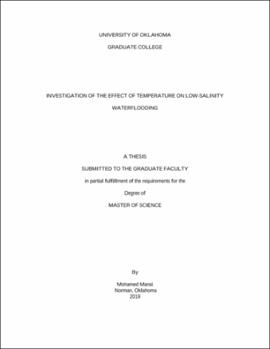| dc.description.abstract | Even though Low-Salinity Waterflooding (LSW) has been under investigation as a promising Enhanced Oil Recovery (EOR) technique for almost three decades, most of the studies in the literature are focused on investigating the controlling mechanism, while the effect of temperature was rarely studied systematically. So, it is crucial to understand the effect of temperature on LSW to see if LSW can be applicable at elevated reservoir temperatures.
The present work investigates the effect of temperature on LSW in sandstones integrating thermodynamic modeling and core-flooding experiment. In the thermodynamic front, we used Surface Complexation Modeling (SCM) to study the effect of salinity and temperature on the adherence of crude oil to sandstone surface over a range of temperatures up to 150ºC. Two brines have been used to represent the case of high and low salinity. In addition, the heterogeneity of the crude oil composition has been considered by using three crude oils with different Total Base Number to Total Acid Number ratio (TBN/TAN). On the other hand, we introduced a core-flooding workflow to determine the impact of temperature on LSW in sandstones. Gray Berea sandstone that have around 9% clay content has been used in core-flooding tests at different displacing temperatures 55ºC and 25 ºC.
The results from SCM show that temperature has a clear effect specially in Crude-oil/Brine/Rock system that has basic or neutral oil. In other words, any experimental work done at low temperatures might give a misleading result about the success of LSW projects, and further investigation at elevated reservoir temperatures should be done. On the other hand, experimental results from core-flooding experiment wasn’t very conclusive. However, it gives an indication that the Low salinity waterflooding is not effective as a secondary recovery mode for the used system. | en_US |
